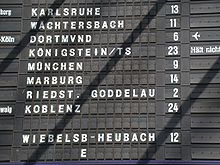Display device


A display device is an output device for presentation of information in visual[1] or tactile form (the latter used for example in tactile electronic displays for blind people).[2] When the input information that is supplied has an electrical signal the display is called an electronic display.
Common applications for electronic visual displays are television sets or computer monitors.
Types of electronic displays
In use
These are the technologies used to create the various displays in use today.
Mechanical types
- Ticker tape (historical)
- Split-flap display (or simply flap display)
- Flip-disc display (or flip-dot display)
- Vane display
- Rollsign
- Tactile electronic displays are usually intended for the blind. They use electro-mechanical parts to dynamically update a tactile image (usually of text) so that the image may be felt by the fingers.
- Optacon, using metal rods instead of light in order to convey images to blind people by tactile sensation.
See also
- Comparison of CRT, LCD, plasma, and OLED displays
- Graphical user interfaces
- History of display technology
- User interface
- Input device
- Text display
References
- ^ Lemley, Linda. "Chapter 6: Output". Discovering Computers. University of West Florida. Archived from the original on 14 June 2012. Retrieved 3 June 2012.
- ^ "Accommodations For Vision Disabilities". Energy.gov. Office of the Chief information Officer. Archived from the original on 9 June 2012. Retrieved 3 June 2012.
External links
- Society for Information Display - An international professional organization dedicated to the study of display technology
- University of Waterloo Stratford Campus - A university that offers students the opportunity to display their work on the school's 3-storey Christie MicroTile wall.
